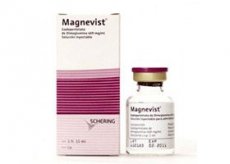Medical expert of the article
New publications
Preparations
Magnevist
Last reviewed: 03.07.2025

All iLive content is medically reviewed or fact checked to ensure as much factual accuracy as possible.
We have strict sourcing guidelines and only link to reputable media sites, academic research institutions and, whenever possible, medically peer reviewed studies. Note that the numbers in parentheses ([1], [2], etc.) are clickable links to these studies.
If you feel that any of our content is inaccurate, out-of-date, or otherwise questionable, please select it and press Ctrl + Enter.

The intravenous substance Magnevist is a paramagnetic contrast fluid used for MRI studies.
 [ 1 ]
[ 1 ]
Indications Magnevist
Magnevist is a specific drug that is used for diagnostic purposes:
- for conducting contrast magnetic resonance imaging of the brain and spinal cord (diagnosis of neoplasms, metastasis, differentiation of tumors);
- for performing contrast magnetic resonance imaging of the torso, cranium, pelvic and chest area, mammary glands, vascular network (diagnosis of neoplasms, inflammatory processes, vascular lesions).
Magnevist can be used to determine the quality of surgical treatment, to detect postoperative relapses, and for various types of differential diagnostics.
Release form
Magnevist is available as a solution for intravenous injection, 0.5 mmol per ml. The solution is packaged in glass vials, sealed with a rubber stopper and rolled up with an aluminum lid. The solution can also be poured into special glass syringes sealed in a hermetically sealed PVC container. Each release of the drug is accompanied by instructions.
Pharmacodynamics
Magnevist is not a drug. It is a paramagnetic contrast agent, a substance that improves visualization in MRI.
The contrast effect is due to the combination of gadolinium and pentetic acid. The use of a specific imaging sequence using contrast enhancement allows for increased signal intensity and enhanced image clarity of certain tissues.
The active ingredient dimeglumine gadopentate forms almost no bonds with proteins and does not inhibit enzyme activity.
Magnevist does not stimulate the complement system, which almost never leads to anaphylactoid reactions.
Pharmacokinetics
The kinetic properties of Magnevist are similar to those of other highly hydrophilic bioinert compounds (mannitol, inulin, etc.). These characteristics do not depend on the amount of solution administered.
After intravenous injection, the substance is rapidly distributed. The half-life is one and a half hours. The drug does not overcome the blood-brain and blood-testicular barriers. A small dose of the substance may penetrate the placenta, but it is soon eliminated from the bloodstream of the developing fetus.
The main excretion of the drug is through the urinary system. Up to 1% of the total amount of contrast agent is excreted with feces.
Dosing and administration
The contrast agent Magnevist is intended for intravenous administration only. The diagnostic procedure begins immediately after the injection of the drug.
It is advisable to perform MRI on an empty stomach.
Magnevist is administered with the patient in a horizontal position.
The dosage of the drug for MRI of the brain or spinal cord is 0.2 ml per kg of the patient's weight. If necessary, repeat administration can be performed only half an hour after the first injection.
The maximum single dose of the drug may be 0.6 ml Magnevist per 1 kg of weight for an adult patient and 0.4 ml per kg of weight for a child.
For MRI of the torso, 0.2 to 0.6 ml per kg of patient weight is administered, depending on the area being examined and the procedural technique used.
 [ 20 ]
[ 20 ]
Use Magnevist during pregnancy
The effect of Magnevist on the course of pregnancy has not been studied. For this reason, the use of the drug should be carried out very carefully, only if the performance of contrast MRI is vital.
When performing a contrast study during lactation, it is recommended to suspend feeding for 24 hours after the procedure.
Contraindications
Magnevist is not used:
- if there is a possibility of an allergic reaction;
- for diagnostics of newborn babies (up to 28 days);
- in patients with severe kidney disease;
- in patients during the rehabilitation period after liver transplantation.
Relative contraindications to the use of Magnevist are:
- bronchial asthma;
- epileptic seizures;
- pregnancy period;
- moderate kidney disease.
Side effects Magnevist
In most cases, side effects after the introduction of Magnevist are minor and quickly disappear on their own. However, sometimes such symptoms can be pronounced:
- dizziness, disorientation;
- change in taste sensations;
- the appearance of convulsions, paresthesia, tremors in the limbs;
- development of conjunctivitis;
- increased heart rate, rhythm disturbances;
- thrombosis;
- difficulty breathing, discomfort in the larynx and throat, cough;
- pain and discomfort in the abdomen, diarrhea;
- dental pain, dry mouth;
- dermatitis, skin redness;
- arthralgia;
- swelling, feeling of fatigue;
- thirst.
Overdose
An overdose of Magnevist is possible when injecting a dose exceeding 0.3 mmol per kg of the patient's weight.
Signs of overdose:
- dehydration;
- increase in circulating blood volume;
- increased diuresis (osmotic);
- increased pressure in the pulmonary artery.
In case of severe signs of Magnevist overdose, hemodialysis may be used.
Interactions with other drugs
Allergy is possible when using the contrast agent Magnevist and β-blockers together.
There is no other information on drug interactions with Magnevist, so the simultaneous administration of other medications is undesirable.
Storage conditions
Shelf life
The shelf life of Magnevist is up to 5 years.
 [ 24 ]
[ 24 ]
Attention!
To simplify the perception of information, this instruction for use of the drug "Magnevist" translated and presented in a special form on the basis of the official instructions for medical use of the drug. Before use read the annotation that came directly to medicines.
Description provided for informational purposes and is not a guide to self-healing. The need for this drug, the purpose of the treatment regimen, methods and dose of the drug is determined solely by the attending physician. Self-medication is dangerous for your health.

